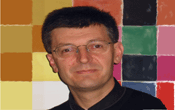|
Dr David Saunders
The National
Gallery in London houses
one of the greatest collections of European painting in the world.
The pictures must be both conserved for the future, and made easily
available to both the public and the specialist.
Abstract
This talk will
illustrate how digital imaging can be used to examine the structure
and composition of paintings, complement traditional analytical
methods, and how complementary data from more than one imaging
method can be combined to give a more complete interpretation
of the artist’s methods and technique.
Digital imaging is increasingly replacing traditional methods of documenting
and examining paintings, to build image libraries that can be used for specialist
consultation in museums, galleries or universities, to make art more accessible
to the public, and for the reproduction of images in books, catalogues and
posters.
Of more interest to the conservator or scientist, however, are the advantages
that these techniques bring to the understanding of paintings, including visible
imaging to measure and monitor changes, infrared reflectography to examine
underdrawing and changes in composition (pentimenti), X-radiography
to examine compositional changes and painting structure, and raking light (illumination
from a low angle) to study the surface texture of paintings.
Biography
After completing a
PhD in organometallic chemistry and a brief
period of post-doctoral research at the University of Bristol, David Saunders
joined the Scientific Department at National Gallery, London, where he is now
a principal scientific officer. His research interests include the effect of
light and climate on paintings, investigating the deterioration of artists’ materials,
methods of preventing deterioration, long-term study of colour changes in paintings,
and non-destructive analysis, particularly using imaging techniques. The last
of these interests has led to involvement in a number of European Community-supported
projects (VASARI, MARC VISEUM, ACOHIR, ARTISTE, SCULPTEUR and CRISATEL) in
the area of digital imaging of two and three-dimensional works of art.
In
the field of museum lighting, David Saunders served on the committees
and editorial committees for both the Chartered Institute of Building
Services Engineers (CIBSE) guide to lighting in Museums and Galleries
(1994) and the Commission Internationale de l’Éclairage (CIE)
technical report on damage to museum objects by optical radiation
(2004).
David
Saunders has been closely associated with the International
Institute for Conservation (IIC) since joining the National
Gallery. He became an editor of its main journal (Studies
in Conservation) in 1990 and in 2002 took on the additional
role of Director of Publications for the IIC, responsible
for all its paper and electronic publications. In addition,
he served on the technical committees for the 1994 and 2000
IIC Congresses. He was elected a Fellow of the International
Institute of Conservation in 1993, and in 2003 was elected
to the IIC Council. He has also been an active member of
the International Council for Museums Committee for Conservation
(ICOM-CC) working groups for Preventive Conservation and Paintings
Conservation since 1990.
In
1996 he was member of the judging panels for the Museum and
Galleries Commission’s Conservation Awards and in 2004
a judge for the Digital Preservation Award at the Pilgrim Trust
Conservation Awards.
|
 |

|
